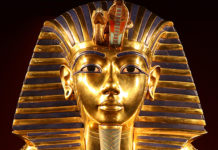Few hard facts are known of Somerled, an early King of the Isles and the Lord of Argyll and Kintyre in ancient Scotland. Little more is known of his son, Good John of Islay, who in the year 1354 became the first Lord of the Isles.
Good John of Islay’s appointment as Lord of the Isles effectively begins a 400-year struggle between the Gaelic-speaking population of the western Scottish islands and the English-speaking mainland population, which by this time was primarily descended from the Anglo-Saxons who invaded and colonized Britain centuries before. It also provided a foundation for the MacDonald clan, who held the Lordship of the Isles for over 200 years, so named for their descendancy from Good John’s younger son, Donald. (Donald had been appointed by his aging father as Lord of the Isles and High Chief of Clan Donald. Donald’s elder brother, Ranald, became the progenitor of the MacDonalds of Clanranald and later the McDonnells of Glengarry.)
Recent archaeological excavations at Finlaggan on Islay have shed a surprising light on the lifestyle and level of cultural advancement of the Lords of the Isles during the 14th and 15th centuries. Their contemporaries on the mainland considered them savages because they spoke the Gaelic language and lived far outside the law of the Scottish crown, yet because of information gained from excavations conducted since 1990 by the National Museums of Scotland, we now know that they lived in a relatively sophisticated society and engaged in trade and diplomatic activities with continental Europe, and in local manufacturing activities.
There are two overgrown islands in Loch Finlaggan – Eilean Mor, the larger, and Eilean na Comhairle, the smaller. On Eilean Mor, partial remains of some 20 buildings have been discovered. These buildings would have included a chapel, two halls, kitchens, workshops, storage houses, and family dwellings. Each of these buildings was connected to the others by paved roads and walkways, which indicates a regard for ease of travel and orderliness which was uncommon in villages and towns elsewhere in early Scotland.
Eilean na Comhairle was the site of the meeting place of the Council of the Isles, upon which the Museum’s excavations revealed two buildings, one of which is believed to have been the council chamber. Other structural remains discovered around the shores of Loch Finlaggan broaden this picture to that of at least an early cultural and trade center based in proximity to its local government. Artifacts unearthed at these sites include pottery wine jars from Bordeaux, coins from England, a 14th century enamelled pendant from France, and a pilgrim’s badge from Rome. Local craftsmen are believed to have built harps to be sold both locally and abroad, and to have worked in iron and lead mining and manufacturing.
After more than a century of attacks and counter-attacks, the Lords of the Isles were defeated by the Scottish crown near the end of the 15th century. There is evidence that their stronghold at Finlaggan was systematically dismantled, that buildings were taken apart and the materials separated so that those which were reusable could be transported to other sites. At any rate, Finlaggan was completely destroyed, which effectively prevented the local population from quickly rebuilding the local center of power. The next evidence of settlement at the Finlaggan sites occurs nearly a century later.








